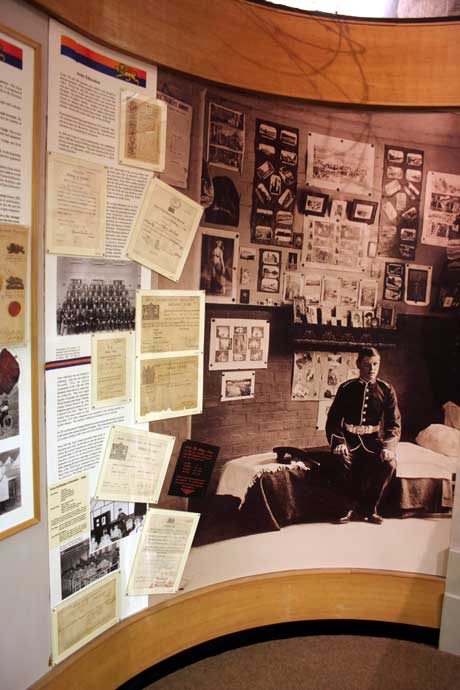Museum Display Information
Army Education

In the 17th and 18th Centuries the majority of soldiers were thought
to need no form of education at all. All they needed to know was how to
follow orders. Even in the mid 19th Century there was a fear that if
soldiers became educated they would question orders and discipline could
break down. The education of soldiers took second place to the education
of soldiers’ families. Emphasis was placed upon schools for children
rather than for the soldiers themselves. A soldier could attend the
school along with the children if he wished - but not many did since
they had to pay for the privilege!
Regimental Schools were began appearing from 1812 and men who attended
were excused evening parade. Gradually more and more time was allowed
for study as this was seen as an important way of preparing promotion.
In 1846 the Corps of Army Schoolmasters was established, and in 1860 the
Council of Military Education took control of all army schools and
libraries. They also introduced the Army Certificates of Education,
which were needed if a soldier wanted promotion.
In 1877 about half of the serving soldiers had received some form of
certificate. Two years later all soldiers were required to attend
school. From 1890 a soldier could not draw his full proficiency pay
until he had gained a 3rd Class Certificate of Education. The civilian
Education Act of 1870 meant that far more soldiers joining the army had
receive some form of elementary education.
By 1912 about 85% of other ranks had received some form of education.
Some NCOs became teachers, assisting the schoolmaster. They were known
as 'Soldier Assistants'
During the First World War many schools of instruction were formed. They
covered topics such as gunnery, bombing, bayonet fighting, trench
mortars, gas technique, mining, cooking and sanitation. After the peace
in November 1918 the platoon commanders of the 1/4th and 1/5th
Battalions held classes to equip men for civilian work and life. They
were taught English, geography and elementary French amongst other
things. With the coming General Election the 1/5th Battalion organised a
lecture on 'How to Record Your Vote'. There was a holiday from school on
14th December when companies were marched to the polling booths in the
chateau. The wartime coalition government was returned to power.
In 1931 an Educational Training Manual was issued and greater attention
was given to the needs of the general education of soldiers. This in
turn improved the chances of a soldier receiving civilian employment at
the end of his military service.
From 1942 the Army Council permitted three hours of education each week
- the first hour to train the man as a citizen, the second to train a
man as a soldier and the third as an individual. In 1945 the army
introduced a major education scheme, for all demobilised soldiers.
Instruction was given in a wide range of subjects and skills. Men of the
107th Royal Armoured Corps (The King's Own) were taught up to 20
subjects in what was known as 'The King's Own College'.
Army Certificates of Education 1930s
Third Class
 | Arithmetic Vulgar Fractions |
 | Elementary Geometry |
 | Practical Measurement |
 | Applications of Money |
 | English |
Second Class
 | More Advanced Maths |
 | Essay writing |
 | Questions on a set book |
 | Written and practical map reading |
 | Paper on the Army and Empire |
This paper was now compulsory for all soldiers and they had to attend
school until they passed it. Without the Second Class Certificate no
promotion was possible or proficiency pay paid.
First Class
Covered everything in the Second Class Certificate but at a higher
level, and including Geography.
Still essential for higher promotion above the rank of Sergeant.
Army Special Certificate
This was at the highest level, with advanced papers on a wide range
of subjects. Specialist subjects such as theory of music and musical
history were undertaken by Bandmasters.
The King's Own Royal Lancaster Regiment in 1882
Out of a total of 518 Other Ranks, 416 held Certificates of
Education, 80% of the total.
| First Class |
2 |
|
| Second Class |
82 |
15% |
| Third Class |
114 |
22% |
| Fourth Class |
218 |
42% |
Only one other regiment approached this standard. In the majority of
regiments less than 50% of the men held certificates.
© Images are copyright, Trustees of the King's Own Royal Regiment Museum.
You must seek permission prior to
publication of any of our images.
Only a proportion of our collections
are on display at anyone time. Certain items are on loan for display
in other institutions. An appointment is required to consult any of
our collections which are held in store. |


